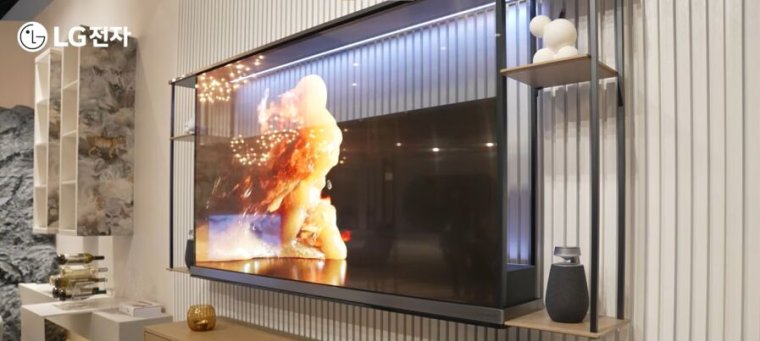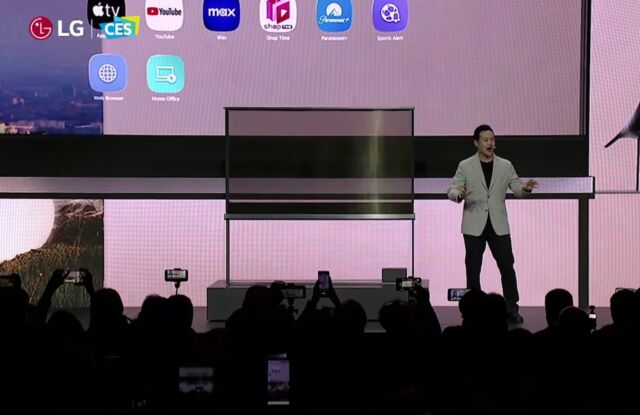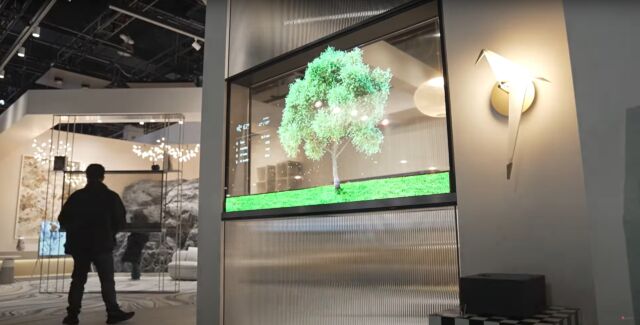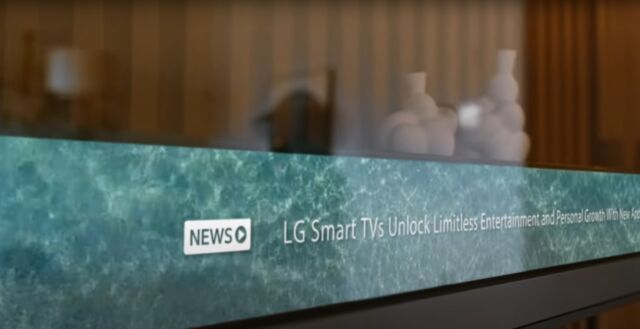Expect it to be extremely expensive.

LG today announced plans to sell a TV with transparent-display technology that has almost exclusively been relegated to commercial applications and demonstrations at tech shows.
LG is showing off the Signature OLED T at CES 2024 (which officially starts tomorrow). LG says the see-through TV will be available this year but hasn’t shared pricing. Still, it’s remarkable to see transparent tech make its way into a consumer TV, even if it is expected to be extremely expensive. Other groundbreaking, Signauture-branded OLED designs from LG have cost six figures.
During a press event today, LG executives discussed the OLED T as a way to satisfy customer demand for bigger TVs without those mammoth displays always dominating the living room.
To fit more seamlessly into home layouts, the OLED T can be transparent when turned off or on. During demos before CES, LG showed the TV in transparent mode, with parts of the image that users would want to stay visible appearing “bright enough to retain a remarkably intense presence in front of the wall you can see behind them,” per Forbes, which saw a demo of a non-finalized version of the OLED T.Advertisement
During LG’s livestreamed press conference, the OLED T appeared to allow the audience to see the presentation behind the TV. CNET’s David Katzmaier reported that the screen looked less transparent than glass during his demo, yet he could see a vase behind the TV.
ADVERTISING

When you want the TV to look like a regular TV, a remote button makes the TV’s black contrast film roll up from a box behind the display.
If the idea of a TV with rolling display parts sounds familiar, you may remember another LG TV, the OLED R, which has a display that rolls down into a box beneath the screen so that the display’s out of sight. That TV debuted at $100,000 in 2021, which doesn’t bode well for the OLED T’s affordability.
That said, during LG’s event, the OLED T’s contrast screen seemed to roll up and down slowly and seamlessly. Of course, we’ll have to take LG’s demo with a grain of salt, especially since the TV’s design hasn’t been finalized yet.
Demo-ready
Reports of LG’s close-up OLED T demos suggest that the company succeeded in creating a transparent effect that “gave off a sense of depth,” per The Verge. Forbes said that the TV succeeded in no longer being transparent when its black film was rolled up.
For CES, LG is demonstrating potential use cases for operating the TV’s transparency mode while the TV is on.
For example, LG has demoed the TV featuring a full-screen weather page that shows an animation based on the current weather. Forbes reported that the seasonal animations were “almost bizarrely ‘beautified’ by the animation being overlaid against the three-dimensional space you can see ‘through’ the screen.”

LG is also showing the TV’s transparency mode reacting to what’s on the screen. Digital Trends reported that “in one demonstration, the contrast screen was triggered by what was on the display at a specific time, and LG says it’s working with content partners to expand on that idea.”
Not the best picture quality
The OLED T doesn’t offer LG’s best picture quality and will force users to pay a premium for the unique form factor. LG told CNET that performance is closer to LG’s C4, which is a step down from LG’s G4 2024 flagship OLED TV. The OLED T, which uses LG’s Alpha 11 processor, won’t be as bright as LG’s premium OLED TVs from 2023 and beyond, which use a microlens array for a claimed 70 percent brightness boost. Considering the OLED T’s expectedly exorbitant price, that’s a big hit to the product’s already minimal practicality. LG hasn’t shared the OLED T’s specs yet.Advertisement
But this TV isn’t for people seeking the highest specs or the finest OLED-watching experience. It’s for people who want to show off a one-of-a-kind TV and blow people’s minds at dinner parties. This won’t be a bestseller, but the TV should finally bring transparent display technologies to a consumer product.

That’s also why the TV—as if it doesn’t have enough shock value—has a wireless box so that the only cord for the OLED T is its power cord. This also supports the TV’s marketed intention of freeing up living room space. Like LG’s OLED M-series TVs, I/O is related to the TV’s Zero Connect Box, which works with the TV from up to a 30-foot distance with a line of sight. One could use the box, which also has a power cord, for attaching external speakers, but the OLED T has integrated downfiring speakers. Forbes reported that during the demo, the speakers “lacked a little directness” but were “still reasonably powerful and detailed.”
More to come
LG is still finalizing the TV’s design, including whether or not it will come with the metal frame it currently has.
Meanwhile, the OLED T provides an energizing jump-start to CES by showing what transparent displays can look like for consumer products. Samsung started mass-producing transparent LCDs in 2011. And in the years since, we’ve seen transparent displays used for things like digital signage and advertising. Beyond 2009’s Sony Ericsson Xperia Pureness phone, though, consumers haven’t had many transparent screens on their devices.
With CES this week, hopefully, we’ll see more designs that use the developing technolog




